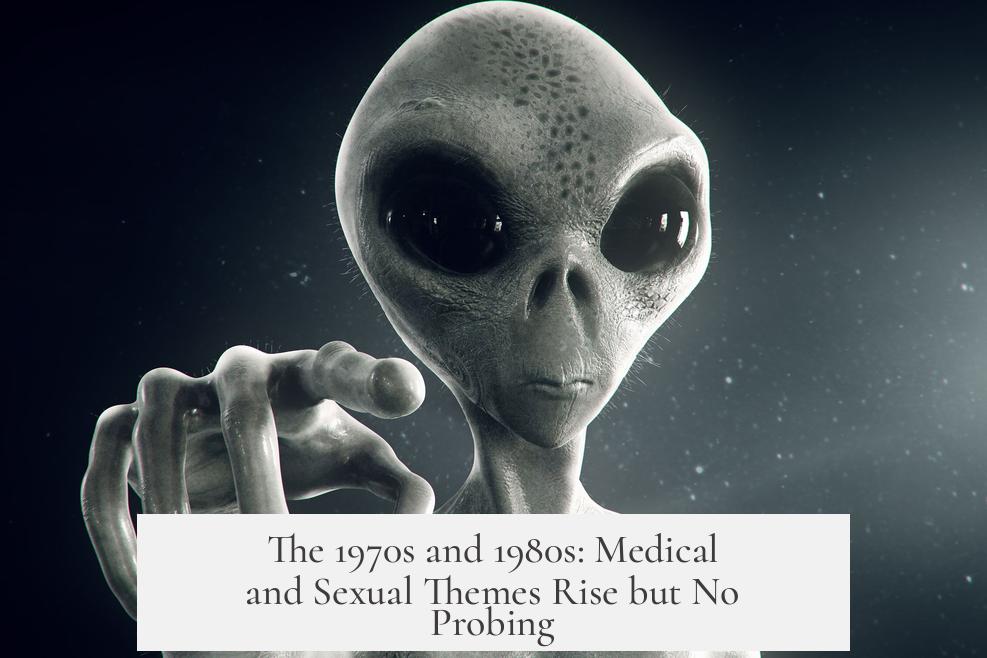Anal probing became associated with alien abductions primarily through early abduction reports that described invasive medical examinations, including rectal probes, but this detail was initially suppressed in public retellings before gaining prominence in the late 1980s media and culture.
Alien abduction narratives began attracting public attention following the Roswell incident in 1947. The first widely known abduction story was that of Barney and Betty Hill in 1961. Both described medical examinations by aliens during their abduction. Betty Hill recounted collection of hair and fingernails alongside an intrusive needle insertion into her belly button. While Barney Hill, after hypnosis, reported a probe inserted into his rectum, apparently for collecting sperm. This early mention of anal probing marks the origin of the association.
The Hills’ narrative shaped the standard abduction script that includes medical exams. A NICAP (National Investigations Committee on Aerial Phenomena) report further details Barney Hill’s experiences: touching of genitals to extract a sperm sample, skin scrapings, ear and throat checks, and finally a cylindrical object inserted into his rectum for extraction purposes.
Despite such early mentions, the public dissemination of the Hills’ story from 1965 onward deliberately omitted the anal probe detail. Reasons for this omission remain unclear but likely involve societal discomfort with sexual topics, especially anal or sexual violations. Another early abduction account from a Brazilian farmer, Antonio Vilas Boras, involved reproductive themes but lacked widespread traction partly due to its sexual content.
During the 1970s and 1980s, alien abduction stories continued to incorporate medical testing and themes of sexual reproduction. However, explicit references to anal probing remained absent in mainstream narratives.
The year 1987 marked a turning point. Two notable media events influenced public attention toward anal probing. First, U.S. President Ronald Reagan underwent widely publicized colonoscopies and related treatments. The extensive coverage familiarized the public with rectal medical procedures. Secondly, Whitley Strieber’s memoir Communion offered a detailed account of his alien encounters and introduced the anal probe explicitly as an act of sexual violation or rape. Strieber’s portrayal, in which aliens inserted a device into his rectum for sampling, evoked a strong emotional response, linking the probe to themes of assault.
These developments reflected wider cultural anxieties. The late 1980s saw strong public attitudes about homosexuality, influenced by the AIDS crisis. Homophobic stereotypes and fears, especially linking to masculinity and bodily violations, found expression in colonoscopy humor and media. This context helped the anal probe narrative gain traction by resonating with sensitive societal issues.
Further shaping the narrative was the delayed public disclosure of earlier reports that contained similar themes. Stories like those of Albert Lancashire from 1942 and Budd Hopkins’ 1980s accounts of reproductive violation hinted at invasive medical procedures, but they surfaced publicly only after the Hills and Strieber stories popularized such ideas.
By the 1990s, anal probing became embedded in popular culture. Strieber’s memoir was adapted into a 1992 film featuring a memorable probing scene. The trope reached mass market saturation with the 1997 airing of the animated TV show South Park’s “Cartman Gets an Anal Probe”, cementing the connection between alien abduction and anal probing as a cultural phenomenon.
In summary, two key phases define the emergence of anal probing in alien abduction folklore:
- Early reports (1960s), particularly Barney Hill’s experience, introduced the concept but were censored or downplayed in public dissemination.
- The late 1980s to early 1990s media and social context allowed the narrative to re-emerge vividly, linking anal probing to sexual violation and embedding it in popular culture.
This development reflects both the evolving nature of alien abduction lore and shifting cultural attitudes toward sexuality, medicine, and bodily violation.
- Barney Hill’s 1961 abduction story first mentioned anal probing but was censored in subsequent publicity.
- Whitley Strieber’s 1987 memoir explicitly described anal probing as a traumatic experience.
- Ronald Reagan’s publicized colon medical procedures in the 1980s influenced public perceptions.
- Delayed public disclosure of earlier abduction reports added to the lore.
- 1990s media, including film and television, popularized and embedded the concept in popular culture.
How did anal probing become associated with alien abductions?

Anal probing became linked to alien abductions mainly due to the Barney and Betty Hill case in the 1960s and later the media impact of Whitley Strieber’s 1987 memoir, Communion. Early reports included mentions of medical tests and probing, but the specific detail of anal probing was initially suppressed in public retellings before gaining widespread attention in the late 1980s and popular culture.
Now, let’s unpack how this strange and unsettling detail wormed its way into alien folklore — and why it stuck around.
The story begins soon after the famous Roswell event in 1947, which kicked off a surge of UFO encounter tales. But the real game-changer was the Hills’ abduction account. Barney and Betty Hill were American couple abducted in 1961—or so they say. Under hypnosis, Betty remembered medical procedures performed by greys, featuring hair, nail sampling, and a weird needle through her belly button. But here’s the kicker: during Barney’s hypnotic sessions later, he reported something more controversial—a probe inserted into his rectum, suspected to be for collecting sperm.
This was groundbreaking. Suddenly, alien abductions weren’t just about blurry lights or missing time; they involved invasive, intimate medical tests.
Why Was the Anal Probe Detail Suppressed?

Interestingly, when the Hills’ story hit mainstream media in 1965, the anal probe detail was quietly excised. Why? Probably because describing anal penetration on national television or print media just wasn’t socially acceptable back then. The 1960s U.S. was far more prudish about discussing anything sexual, especially anything linked to trauma or non-consensual acts. Also, anal probing carried implications of sexual violation and rape, which editors likely wanted to avoid upsetting audiences with.
Adding to this was the tale of Brazilian Antonio Vilas Boas, a farmer abducted in the 1950s who claimed alien rape for reproductive purposes. His story fizzled out, perhaps because it was too explicit for public taste. In contrast, by 1965, sci-fi charmers like Star Trek’s Captain Kirk made sexual themes more palatable, but the dark and invasive nuances of anal probing remained taboo for a while.
The 1970s and 1980s: Medical and Sexual Themes Rise but No Probing

Through the 70s and much of the 80s, alien abduction stories embraced medical exams and implied reproductive experiments. However, the infamous “backdoor” probe remained in the shadows. UFO folklore focused on strange examinations without explicit mention of rectal probing until late in the ’80s.
The pivotal moment comes in 1987 with two sensational events:
- President Ronald Reagan’s widely publicized colonoscopies. In the mid-80s, news about Reagan undergoing colonoscopies and surgeries thrust the idea of anal medical procedures into public awareness. Colonoscopies were no longer hidden secrets but openly discussed serious medical treatments for the leader of the free world.
- Whitley Strieber’s memoir Communion released in 1987. Strieber, a well-known author, detailed encounters with alien beings and graphically described anal probing. He portrayed it as a violent, invasive act—essentially alien rape. This was the first time anal probing was openly connected to alien abduction in popular nonfiction, producing shock and fascination.
Why Did Strieber’s Revelation Ignite Public Imagination?

The timing was perfect. Public discourse was already tuned to medical themes involving the colon, thanks to Reagan’s treatments. Strieber’s vivid account, presented as memoir rather than fantasy, raised eyebrows and spread quickly. At the same time, society was grappling with attitudes toward masculinity and sexuality, especially amid the AIDS crisis of the 1980s. The taboo around anal sex, linked wrongly or rightly to disease and stigma, amplified the horror and attention surrounding alien anal probing.
Earlier Stories Revisited But Reported Too Late

Here’s a twist: several older abduction stories with similar medical themes existed before the Hills, including Albert Lancashire’s 1942 tale which featured medical exams and amnesia. However, these older accounts only surfaced publicly after the Hills’ story was famous. That means the Hills set the template—and the anal probe, even if initially suppressed, loomed beneath the surface.
Similarly, Budd Hopkins, a key figure in alien abduction research in the 1980s, gathered stories of reproductive abuse and hinted at anal probes but held back public disclosure until the 1990s. This delay helped cement the idea that anal probing was a growing and genuine part of alien abduction lore rather than an isolated oddity.
The Anal Probe Becomes a Pop Culture Staple

By the 1990s, anal probing was no longer fringe folklore but solidified in popular imagination. Christopher Walken’s unnerving 1992 portrayal of Strieber’s probing in the film adaptation of Communion made it visually unforgettable. Then, in 1997, the animated comedy South Park’s episode “Cartman Gets an Anal Probe” cemented the concept as pop culture shorthand for alien abductions.
This shift from suppressed dark secret to comedic zeitgeist shows how cultural attitudes evolved. What was once a deeply taboo narrative became fodder for parody, stripping away some of its horror but ensuring its place in UFO mythology.
So, Why Has the Anal Probe Detail Lasted?

- It’s vivid and shocking: The visceral image of alien anal probes grabs attention like few other details.
- Sociocultural taboos add intrigue: Mixing science fiction, sexuality, and violation makes it unforgettable and ripe for horror or comedy.
- Repetition reinforces belief: Multiple stories over decades, despite varying details, repeat the trope, solidifying it in public imagination.
- Pop culture embeds it: Movies and TV shows keep the meme alive, exposing new generations to the idea.
Curious Questions for Thought
Why did early abduction narratives contain medical themes but shy away from explicit sexual details? How might public attitudes towards sex and trauma influence what parts of UFO stories become popular or suppressed? And what does the persistence of anal probing in alien folklore say about human fears of violation and control?
While the truth about alien abductions remains elusive, one thing is certain: the story of the anal probe is as much about human culture and taboos as it is about extraterrestrials.
If you want a practical takeaway, next time you hear about alien abductions, consider the layers of storytelling, censorship, medical fascination, and cultural fears wrapped up in the tales. It’s a complex tale woven through decades of societal change, not just a weird alien prank.



